I felt like Humphrey Bogart in "The African Queen" as our boat chugged up the chocolate-brown river, though we were in Borneo and not A
I felt like Humphrey Bogart in "The African Queen" as our boat chugged up the chocolate-brown river, though we were in Borneo and not Africa. Not sure what to expect, we kept a close eye on the riverbanks and trees for wildlife. Though most people traveled to Borneo to see the orangutans at Camp Leakey or the Pondok Tanggui Feeding Station, I was there to see snakes, lizards and crocs, and I had talked my friends, Heath Rucker and Clint Kolz, into joining me—not to see apes in Borneo, but to see the Komodo dragon/monitor (Varanus komodoensis), the world’s largest lizard, on Komodo Island.
The Komodo dragon may grow to over 10 feet in length, though most males average 8.5 feet and between 170 and 200 pounds. The largest one on record was 10.3 feet long and weighed 370 pounds; however, a substantial portion of that weight may have been due to undigested food. Females are smaller than males, growing an average of 7.5 feet and weighing in at 150 to 160 pounds.
Read More
Komodo Dragons Hatch At L.A. Zoo
Komodo Dragon Attacks Park Employees At Komodo National Park
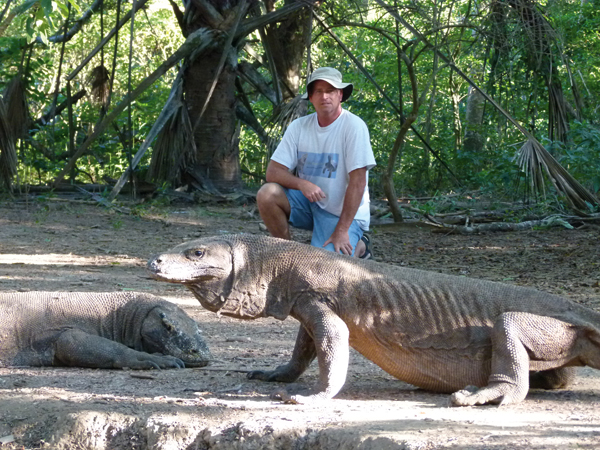
jerry fife
It can be a little intimidating being so close to the world’s largest lizard, though the Komodo monitors on Komodo generally show little interest in humans.
The crocodile monitor (V. salvadorii) may actually grow longer than a Komodo dragon—there are reports of 12-foot specimens—but based on weight, the Komodo maintains the title of the world’s largest lizard. It is also the longest based on average length, as a typical male crocodile monitor will not exceed 8 feet and females seldom exceed 5 feet.
A Stop in Borneo
The Republic of Indonesia is made up of more than 18,000 islands between Asia and Australia, and it took me two days and three flights to fly from Phoenix to Bali, then another two flights to get to Borneo for a short side trip prior to heading to Komodo.
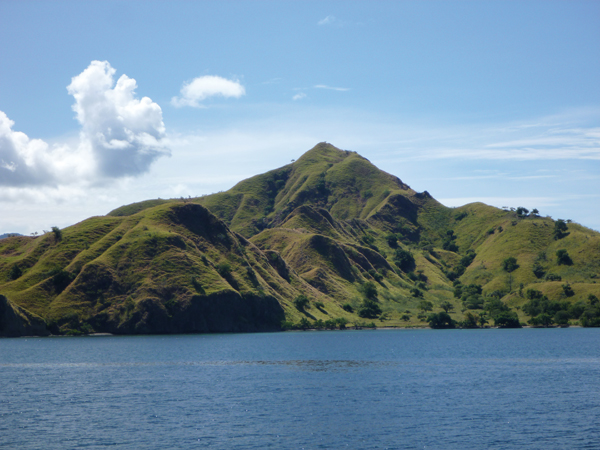
jerry fife
Komodo is one of the three primary islands within Komodo National Park. The other two are Rinca and Padar.
We landed at Iskandar Airport in Pangkalan Bun, in central Kalimantan, where we grabbed a taxi for a bumpy ride to Kumai, the port where we would board our boat. The residents there lived in wood and tin shacks, next to several large concrete buildings that looked like apartment complexes. Our guide explained that the larger buildings were owned by the Chinese and were basically giant bird houses where nests were harvested for bird’s nest soup. The riverbanks were covered with beautiful palm trees which were also harvested, for palm oil. The native forest had been cleared to plant them, one indication of how the natural resources of Borneo were being exploited by the world.
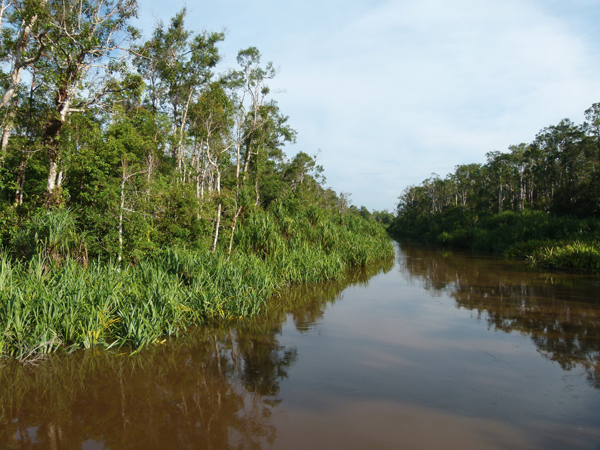
Jerry Fife
In Borneo, the brown water in this river was due to mine tailings further upstream.
The boat began its journey, and though we expected to see a lot of wildlife, we actually saw very little—just a few proboscis monkeys, macaques and some water monitors. The guide said there were crocodiles in the area, though none could be seen in the brown water, which was murky due to mine tailings further upstream. The boat turned to chug up another branch of the river, and suddenly the water became crystal clear.
We kept asking our native guide where all the snakes, lizards and crocodiles were, and I’m not sure if it was because of our teasing, but he eventually told us he would take us to a place where we could see crocodiles. The boat pulled over into a remote area, and we disembarked to hike to a camp. There we came upon a couple guys, who then opened a cooler to show us several small “crocodiles.” These were actually false gharial (Tomistoma schlegelii) hatchlings. The men claimed they had captured the hatchlings to release further down river, but because our guide instructed us not to mention that we saw them to anybody (his reason being that other tourists would be upset because they weren’t given the same opportunity to see them), we feared the endangered crocodilians were part of some type of illicit trading. Although it was exciting to see and hold some false gharials, it was upsetting to think that they were yet another natural resource being exploited in Borneo.
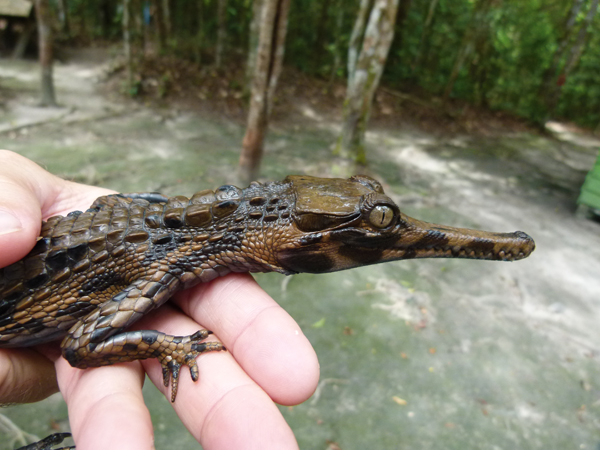
JERRY FIFE
One of the young false gharials the author was shown while in Borneo, quite possibly on its way to being illegally traded.
Our next stop was Tanjung Puting National Park, home of Camp Leakey, where we saw orangutans and water monitors, but no snakes. Seeing monkeys and apes is always interesting and fun, but we were increasingly anxious to get on with our next adventure, to the island of Komodo.
Mr. Jerry Goes to Komodo
After two flights back to Bali we flew from there to Labuan Bajo, a fishing village in the Nusa Tenggara region of eastern Indonesia. From there we embarked upon a two-hour boat trip to Rinca, a small island near Komodo that is part of Komodo National Park and one of five islands where Komodo monitors are found. In fact, per our guide, Rinca is home to more of the dragons than Komodo Island. We would spend the night on the boat moored near Rinca, prior to visiting Komodo the next morning.
Joseph was our guide on the boat, which would be our home for the next few days. I gave him a copy of my book, "Iguanas, A Pictorial Guide to Iguanas of the World and their Care in Captivity," which must have impressed him, because I became “Mr. Jerry” afterward, and all trip decisions were cleared through me. Clint and Heath could say what they wanted to do, but Joseph would always check with me before making a final decision. Of course Heath and Clint didn’t harbor the same respect for me, but they did appreciate the humor of the situation and began calling me Mr. Jerry, as well.

jerry fife
We would spend the night on the boat moored near Rinca, prior to visiting Komodo the next morning.
We got an early start on our Komodo hike the next day because the dragons are most active in the morning and we wanted to see as many as possible. The entry fee to the park was $15, and we had to hire a guide. We weren’t disappointed in regard to dragon sightings, as we immediately saw some in Komodo Village. Though residents are not allowed to feed them, the smell of food cooking attracts dragons from the hills. Most of them are males, and although fights inevitably occur, most of the time they just lie around and sleep.
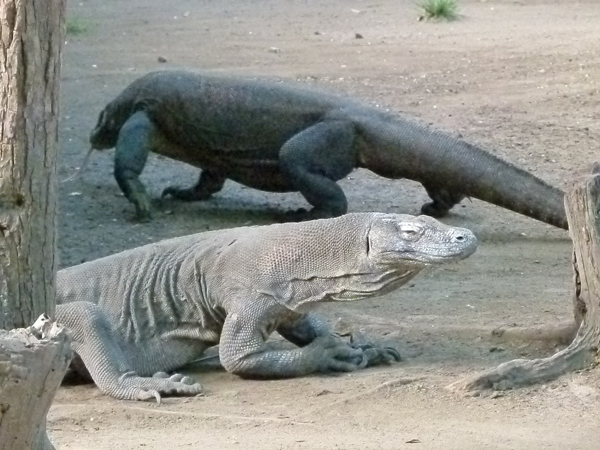
jerry fife
The monitor in the foreground has a bent and broken front leg, which will ultimately doom it to die.
We did see one dragon with a broken leg, the result of a fight. Its leg was permanently bent, and the dragon was extremely thin. It would soon die because it could no longer hunt. The villagers were not permitted to intercede and feed the dragon, either, as nature must be allowed to take its course. This was difficult to witness, but was part of the management plan for the Komodo dragons. Tourism is a major revenue source for the residents of Komodo, and they recognize tourism depends on the welfare of the dragons.
Several different hikes, always with a guide, are available on both Rinca and Komodo. We always chose the longest. The guides are equipped with a forked, wooden stick—I called it their Komodo stick—which could be used to hold back an aggressive dragon. Though it can be somewhat intimidating to be so close to a large, carnivorous lizard, the monitors are not typically aggressive toward people. Guides are quick to point out, too, that there is no guarantee that you will see any on a hike, and once we were away from the village, dragon sightings were infrequent. One exception was at a man-made watering hole, where several had gathered. We also hiked by the spot where guides used to feed goats to the dragons, a practice that stopped around 1990.
Hungry, Hungry Dragons
Two lizards are typically recognized as being venomous: the Gila monster and beaded lizard. Recent evidence suggests, however, that additional species may use venom, and one of them is the Komodo dragon. It was initially believed that bacteria in the monitor’s saliva infected its prey, killing it, followed by the lizard tracking down the fallen prey item and eating it. More recent research, however, has revealed that the Komodo dragon possesses venom glands, and its saliva actually contains venom that aids in the death of its prey.
Prehistoric Inspiration
The Komodo dragon was first documented in 1910 amid rumors of a “land crocodile.” The first expedition to collect specimens for the London Zoo was in 1926, and reportedly was the inspiration for the 1933 movie, King Kong. Though not as remote today, visiting Komodo is still an inspiring adventure that is sure to excite any reptile enthusiast. When we were there, a large boat dock was being constructed that would allow cruise ships to bring many more visitors to the islands. Whether this is good or bad can be debated, but tourism, allowing the selling of hand-carved Komodo dragon figurines and strings of pearls, provides a major and much-needed source of income for the local people.
Some researchers scoff at the notion that venom plays a role in the Komodo monitor’s procurement of prey, arguing that shock and blood loss are the primary factors involved, not venom. What isn’t disputed, though, is that Komodo dragons may hunt in groups, and that they will kill large prey, such as deer and buffalo (Heath, Clint and I were fortunate to see both Timor deer and water buffalo, both common prey animals of the Komodo dragon). Komodo dragons smell using their Jacobson’s organ rather than their nostrils, flicking their tongue to taste and smell stimuli. If wind conditions are right, they can smell and track prey more than five miles away. When the time comes to eat, the largest dragons feed first, tearing and ripping large chunks of flesh that are swallowed whole.
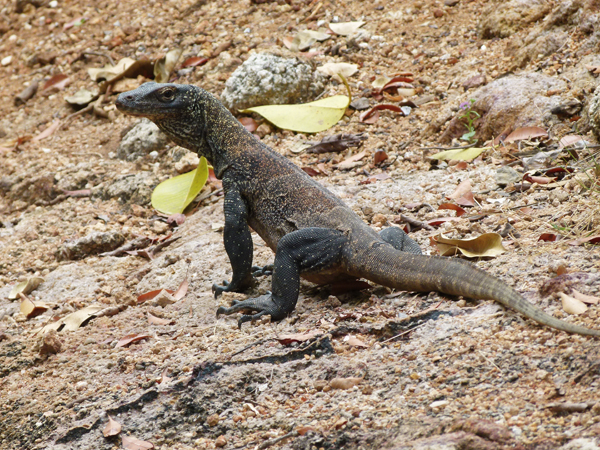
jerry fife
This yearling Komodo monitor displayed attractive coloration.
One surprising find on our trip was a young dragon. Based on its size, I estimate that it was a yearling. It kept its distance but was not flighty and allowed me to follow it and take several pictures. The colors of this young dragon were much more vivid than those of the older dragons and were a positive indicator that reproduction was taking place. Our guide also pointed out some nesting sites where females had dug nests. Komodo monitors nest in September and deposit an average of 20 eggs.
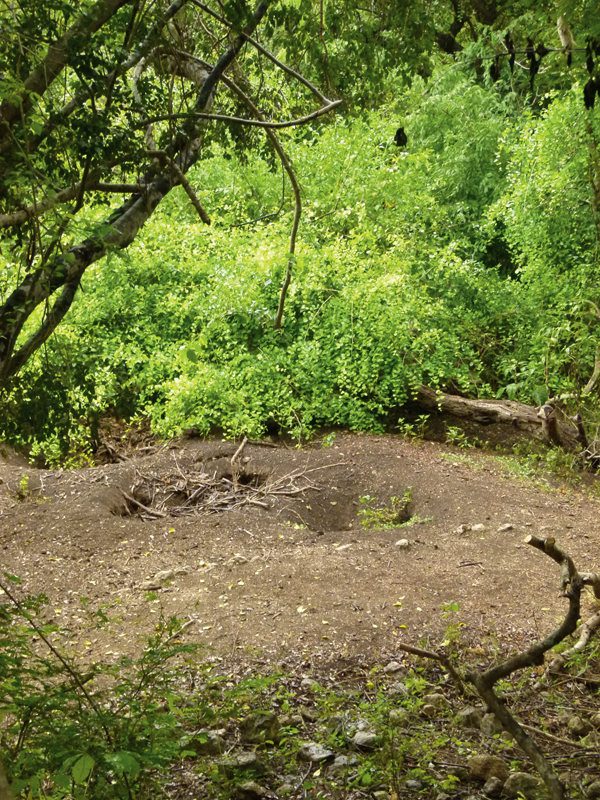
jerry fife
A Komodo dragon nest found during a hike. The lizards nest in September and typically deposit about 20 eggs.
Need to Breed
Reports vary, but estimates generally put 2,500 to 5,000 Komodo dragons as remaining in the wild, of which only about 350 may be breeding females. Most of the specimens we encountered were males. Parthenogenesis, the ability to reproduce without a male, has been confirmed in this species, but while this may seem a benefit for its long-term survival, all offspring resulting from parthenogenesis are male.
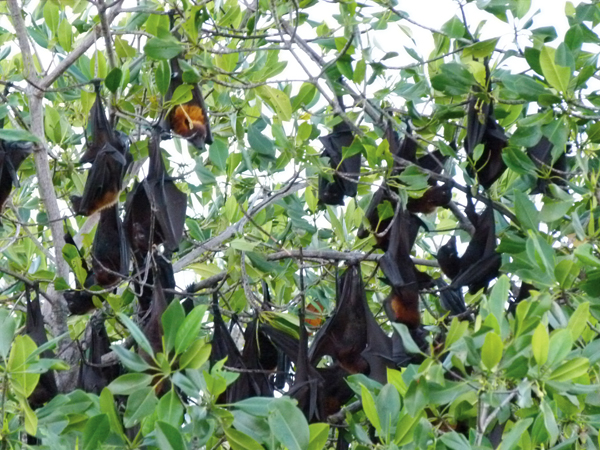
jerry fife
Bats waiting for the cover of night.
While my friends and I were not fortunate enough to see any native cobras or Russell’s vipers, we did get to experience another interesting wildlife sighting during our trip, when our boat was docked next to a mangrove island named Pulau Kalong. It was dusk, and we were treating to the sight of thousands of fruit bats flying from Pulau Kalong to Komodo to feed. These large bats, also known as “flying foxes,” have a wing span of approximately 4 feet.
While seeing Komodo dragons was definitely the highlight of this trip, seeing orangutans and fruit bats, as well as snorkeling for giant manta rays and observing spectacular coral and fish, provided plenty of other great memories of this great trip.
Jerry Fife lives in Phoenix, Ariz., where he breeds a variety of reptiles. He is one of the few private breeders of Galapagos tortoises, and also works with a number of other tortoises, both common and rare, as well as lizard species. He is a frequent speaker and has authored many articles and books. Visit his website at fifereptiles.com.



